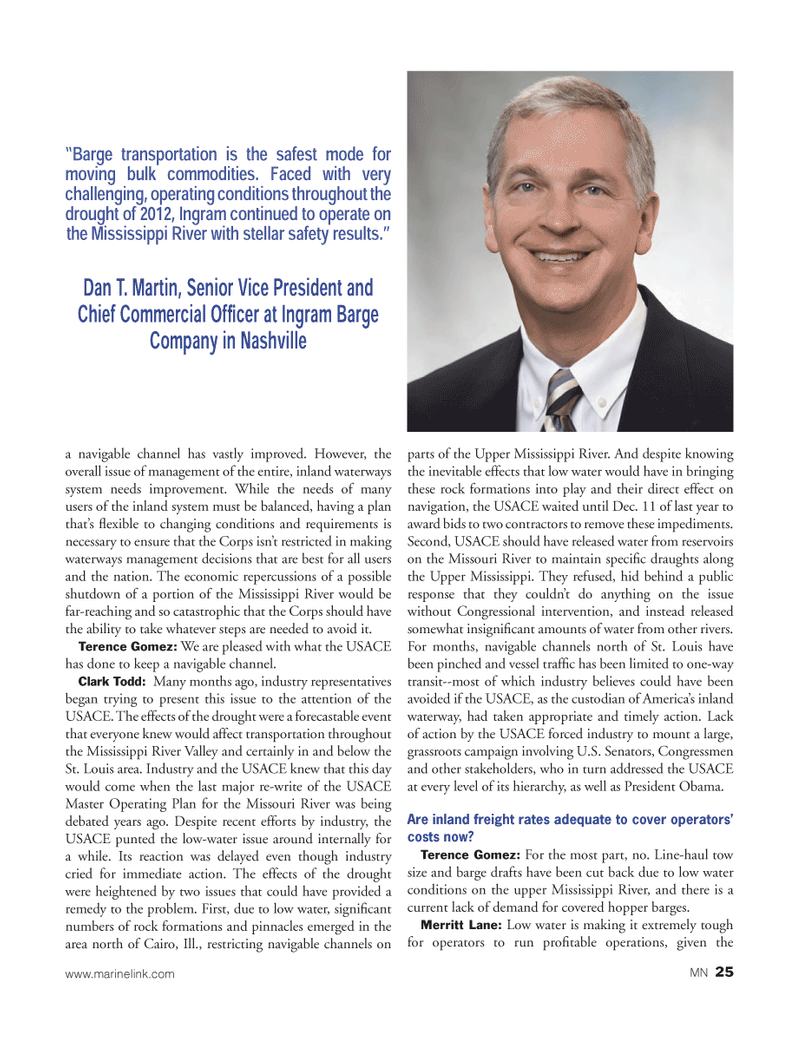
Page 25: of Marine News Magazine (February 2013)
Bulk Transport Leadership Roundtable
Read this page in Pdf, Flash or Html5 edition of February 2013 Marine News Magazine
a navigable channel has vastly improved. However, the overall issue of management of the entire, inland waterways system needs improvement. While the needs of many users of the inland system must be balanced, having a plan that?s exible to changing conditions and requirements is necessary to ensure that the Corps isn?t restricted in making waterways management decisions that are best for all users and the nation. The economic repercussions of a possible shutdown of a portion of the Mississippi River would be far-reaching and so catastrophic that the Corps should have the ability to take whatever steps are needed to avoid it. Terence Gomez: We are pleased with what the USACE has done to keep a navigable channel.Clark Todd: Many months ago, industry representatives began trying to present this issue to the attention of the USACE. The effects of the drought were a forecastable event that everyone knew would affect transportation throughout the Mississippi River Valley and certainly in and below the St. Louis area. Industry and the USACE knew that this day would come when the last major re-write of the USACE Master Operating Plan for the Missouri River was being debated years ago. Despite recent efforts by industry, the USACE punted the low-water issue around internally for a while. Its reaction was delayed even though industry cried for immediate action. The effects of the drought were heightened by two issues that could have provided a remedy to the problem. First, due to low water, signi cant numbers of rock formations and pinnacles emerged in the area north of Cairo, Ill., restricting navigable channels on parts of the Upper Mississippi River. And despite knowing the inevitable effects that low water would have in bringing these rock formations into play and their direct effect on navigation, the USACE waited until Dec. 11 of last year to award bids to two contractors to remove these impediments. Second, USACE should have released water from reservoirs on the Missouri River to maintain speci c draughts along the Upper Mississippi. They refused, hid behind a public response that they couldn?t do anything on the issue without Congressional intervention, and instead released somewhat insigni cant amounts of water from other rivers. For months, navigable channels north of St. Louis have been pinched and vessel traf c has been limited to one-way transit--most of which industry believes could have been avoided if the USACE, as the custodian of America?s inland waterway, had taken appropriate and timely action. Lack of action by the USACE forced industry to mount a large, grassroots campaign involving U.S. Senators, Congressmen and other stakeholders, who in turn addressed the USACE at every level of its hierarchy, as well as President Obama. Are inland freight rates adequate to cover operators? costs now?Terence Gomez: For the most part, no. Line-haul tow size and barge drafts have been cut back due to low water conditions on the upper Mississippi River, and there is a current lack of demand for covered hopper barges. Merritt Lane: Low water is making it extremely tough for operators to run pro table operations, given the ?Barge transportation is the safest mode for moving bulk commodities. Faced with very challenging, operating conditions throughout the drought of 2012, Ingram continued to operate on the Mississippi River with stellar safety results.?Dan T. Martin, Senior Vice President and Chief Commercial OfÞ cer at Ingram Barge Company in Nashvillewww.marinelink.com MN 25MN Feb2013 Layout 18-31.indd 25MN Feb2013 Layout 18-31.indd 251/30/2013 4:49:09 PM1/30/2013 4:49:09 PM

 24
24

 26
26
